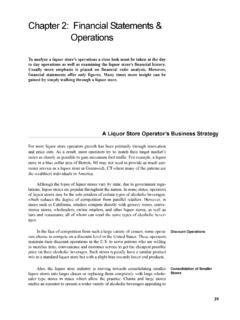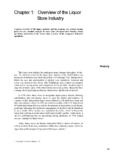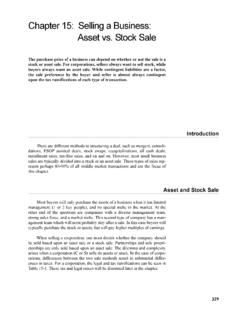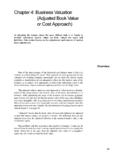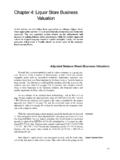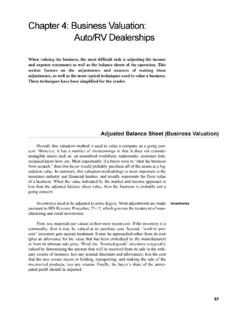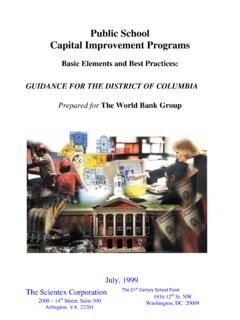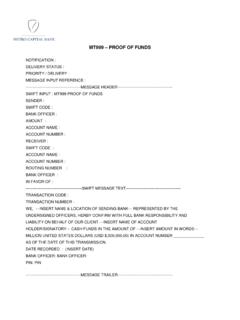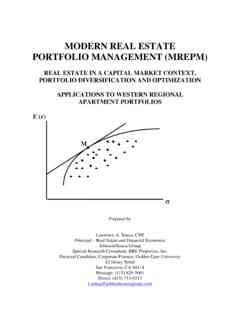Transcription of Chapter 2: Analyzing a Dealership’s Financial Statements ...
1 41 Chapter 2: Analyzing a Dealership s Financial Statements & OperationsTo analyze a dealership s operations, a close look must be taken at the dayto day operations as well as examining the dealership s Financial more emphasis is placed on Financial ratio analysis. However, Financial Statements offer only figures. Many times more insight can begained by simply walking through the acts to drive profit margins and the returns on investmentdown to a free market minimum level. In other words, competition translatesinto lower prices. Therefore, in the long run, the analysis of profit margins(which is a component of return on equity) will depend upon the analysis of afirm s competitive position as well as the competitive position of the industry inwhich it factors determine the choice of a competitive strategy: (1)The long-term profit outlook for the auto-dealership industry.
2 (2)A firm s competitive position within the auto-dealership industry. Both are important. A firm can be in a profitable industry and still do poorlybecause of a bad competitive strategy, or it may have a good competitive strat-egy and do poorly because the industry is order to forecast the profit margin of a company, and its return on equity,one needs to review the basic competitive forces that exist in an industry andassess the strength of each. There are five basic competitive forces as put for-ward by Michael Porter in his book Competitive Strategy: Techniques for Ana-lyzing Industries and Competitors:1(1)Ease of entry and exit(2)Rivalry between existing competitors(3)Pressure from substitute products1.
3 Porter, Michael E. 1980. Competitive Strategy: Techniques for Analyzing Industries and Competitors. New York: Free a Dealership s Financial Statements & Operations42(4)Bargaining power of buyers(5)Bargaining power of suppliersThese pressures are presented in Figure 2-1: Five Basic Competitive Forces Facing an Auto Dealership First, with respect to ease of entry, the following factors affect the decisionof a dealership to enter a given market: capital requirements, economies ofscale, secure distribution channels, strong brand identification, government pol-icy, technological differences, expected retaliation, and absolute cost , rivalry between existing competitors involves such variables asthe number of competitors, the relative strength of the competitors, the strengthof their competitor s relationship with car/truck distributors and manufacturers,the industry growth potential, the amount of fixed costs needed, service differ-ences, and quality of cars available.
4 Third, pressure from substitute products can hurt the auto industry. Theauto industry faces competition not only from within, but also from other formsof transportation such as trains, subways, bicycles, metro transits and needs to focus on substitute products and the minimum switching costs forpotential customers, and high profit earning industries which can afford toreduce margins in order to broaden their market into the seller s , with respect to their bargaining power, buyers can bargain for pricecuts, better quality, and more services. Such actions by buyers tend to lowerprofit margins for sellers.
5 The buyers power depends on their bargaining lever-age, their sensitivity to the price of the product being sold, and the relative avail-ability of substitutes. These variables are: the volume of purchases by the buyerAnalyzing a Dealership s Financial Statements & Operations43as a percentage of the seller s sales, the profitability of the buyer, the percentageof buyer cost that is represented by the product, buyer information, whether thebuyer could duplicate the product from the seller, the product s impact upon thebuyer s business, switching costs, and the seller s ability to influence the , the internet has greatly increased the bargaining power of buyersFinally, the bargaining power of suppliers (car manufacturers)
6 Can reduce afirm s profit margins by raising costs or reducing quality. The conditions thatgive bargaining power to suppliers are: the relative size of suppliers versus buy-ers, the importance of the buyer to the seller, the switching costs, whether thesupplier can penetrate the buyer s market, the degree of organization of the sup-plier, the supply of the supplier s product, and whether the government can con-trol the supplies of certain economic forces are strong enough to create a competitive market, thenthey will place downward pressure on rates of return so as to equal the return toassets used plus a business risk premium.
7 If an industry is earning above aver-age returns, then capital will flow into it causing an expansion of supply andtherefore placing downward pressure upon margins. If the industry is earningbelow average returns, then capital will exit and there will be upward pressureupon is the degree of competition produced by these competitive forces thatdetermines the ability of dealerships within the industry to generate attractiverates of return. If these five factors are favorable, then many dealerships canearn attractive returns; if they are unfavorable and lead to intense competition,then few auto dealers can do well despite good management.
8 The automotivedealership industry profitability is directly related to the industry structure andnot the auto product in which the industry Auto Dealership Owner s Business StrategyFor most dealership owners, growth has been primarily through the acqui-sition of new and more popular automobiles, the expansion of servicing andparts supplies, and creating advantageous franchising agreements with manu-facturers. Most dealership owners have built strong franchising agreements withvehicle manufacturers. A dealership will have a separate agreement with eachmanufacturer. These agreements help the manufacturer govern everything fromminimum working capital requirements, lines of credit, net worth, to personnel,ownership and management.
9 In return for this, the dealerships are given rightsto sell the branded vehicles as well as display trademarks and slogans or logosthat are agreed upon. Larger dealerships wield more bargaining power overmanufacturers than smaller firms. Analyzing a Dealership s Financial Statements & Operations44An auto dealership owner relies upon advertising to help sell cars off thelots. While conventional forms of advertising such as word of mouth, televisionand radio ads as well as flyers and print advertisements were once much moreprominent, the industry trends show that consumers are now more responsive tothe Internet based advertisements.
10 Dealerships often team up with independentautomotive search engines to help refine searches with a more extensive set ofresearching features that include safety ratings, insurance quotes, extended war-ranties and many other options. Besides the sale of new and used cars, dealership owners can generate rev-enues through the sales of parts and repair of old cars and parts. Operating Revenue From DealershipsDealerships generate their revenue primarily from the sale of new and usedvehicles, which they require from the vehicle manufacturers. Dealership RevenueDealership revenues are directly related sales, including the sale of new vehicles that are delivered from manufacturers, the sale of used vehicles, and trade-ins.
